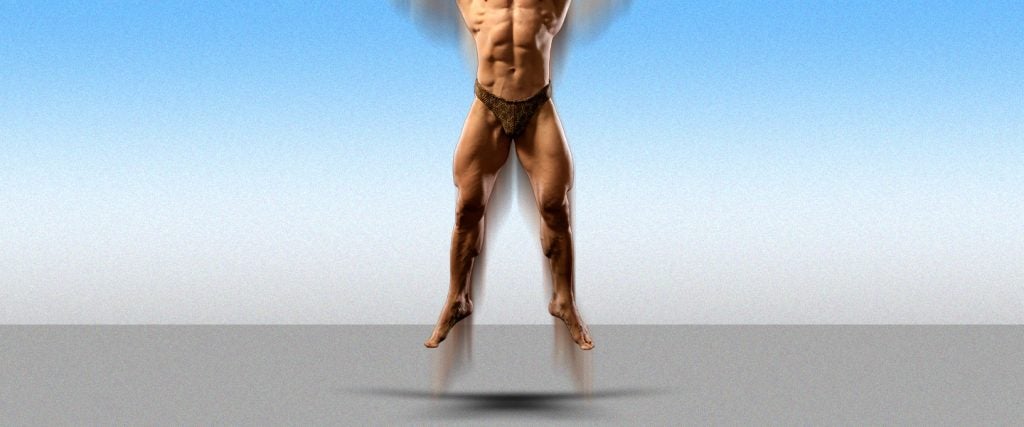The burpee is a magnificent torture mechanism with an innocent origin. What began as a measure of agility, coordination, fitness and combat readiness rapidly evolved into a merciless means for punishing soldiers, school children and eventually personal training clients.
When Royal Hiddleston Burpee invented his signature training movement, he never intended for its users to perform more than four in a row. At the conclusion of the fourth rep, the performer of the exercise was supposed to time how long it took for their heart rate to return to normal. Of course, that little factoid didn’t stop the U.S. military from immediately turning eight completed burpees in 20 seconds into a minimum standard for battlefield preparedness, with 13 reps required to be considered elite.
What muscles do burpees work?
Before we get on the topic of what muscles a burpee works, we need to make sure we’re talking about the same thing, or it may seem like we’re communicating in languages that are altogether different.
Royal H. Burpees’ original gauge of soldier fitness was a squat thrust with an additional stand-up motion inserted in between the repetitions. Nothing more, nothing less. So before you begin asking inane questions like, “Hey, where’s the push-up?!” or lobbing invectives along the lines of “You forgot the jump at the end, Dumbass!” just know that I’m right and you’re wrong.
But what about the pull-up, the curl or the shoulder press?
Dude, please stop.
…or the row?
That’s it — I’m leaving.
Alright! Come back!
Okay, but only if you accept the fact that a squat thrust isn’t called a squat thrust because it involves a full squat; it’s called a squat thrust because it’s executed from a position where your body is squatting over. In the era before every Tom, Dick and Harry understood “squats” to mean a full exercise movement unto itself, “squat” simply referred to a body position.
I can assure you that when Ann James was setting the 8th grade record of 7.5 squat thrusts for her New Jersey middle school in 1950, as recorded for posterity in The Daily Register, she was absolutely not standing up in between her reps, or otherwise she would have been dusting the burpee performances of elite U.S. soldiers from the same time period.
Again, if the argument is that a squat thrust includes a full stand-up movement in between the repetitions, it’s an original burpee, and an original burpee would no longer be its own separate thing. As described in the Miami News in 1942, “This maneuver consists of a series of movements beginning with the position of attention, and progressing through squat, prone and back to attention.” The instant a burpee adds a push-up to its motion, the burpee has been modified. That doesn’t mean a burpee with a push-up has ceased to be a burpee, but it isn’t a foundational requirement for the movement to be deemed an acceptable burpee by historical standards.
Now that we have that out of the way, I’ll quickly point out that if you want to identify what muscles the original burpee works, it’s a simple matter of breaking down the muscles utilized by the body during the performance of the two movements that compose a burpee. The lowering and raising of yourself to the ground in a bodyweight squat position predominantly involves the work of the quadriceps and glutes in your upper legs. The squat-thrusting motion — the shooting back of the legs from the squatting position into a plank position — is generally a resistance-free extension of the legs, but it ends with the body in a position that’s well known to condition the abdominals, along with the erector spinae of the back.
So how many burpees should I do to train these muscles effectively?
If you have access to a gym, or some proper equipment, probably zero.
Seriously?!?!
Yes. If you want to train your abdominals, there are countless ways to do it in a more efficient fashion, and the same holds true for the muscles of your lower body. The burpee was never intended to be a training mechanism for improving fitness; it was a tool for assessing the conditioning of troops by elevating their heart rates quickly. When your favorite muscle-developing tool was invented as a means to quickly elicit a cardiovascular result, you should immediately recognize that it isn’t a particularly efficient muscle developer.
If you’re all alone with no equipment at all, endless burpee repetitions wouldn’t be a bad way to completely wipe yourself out. But that’s like the fitness equivalent to taking on two terrorists that are holding your wife hostage while you’re wearing no shirt, you’re bleeding from both feet, you’re being held at gunpoint and you’re down to your last two bullets. In other words, if you’ve got to rely on burpees as the last resort to get in your strength training and your cardio, you’re having an excruciatingly bad day.

